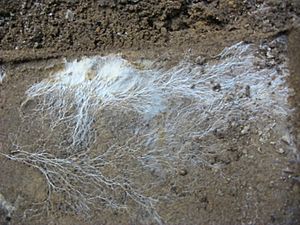Mycelium facts for kids

The mycelium is a very important part of a fungus, like a mushroom. Think of it as the fungus's "body" or "roots" that usually grows hidden underground or inside other things like wood or soil. It's made up of tiny, thread-like structures called hyphae. These hyphae spread out, forming a network that can be very dense, almost like a thick mat.
The main job of the mycelium is to find and absorb nutrients for the fungus. It does this by releasing special chemicals that break down food sources, which the hyphae then soak up. This hidden network is how fungi get all the energy they need to grow.
Contents
What is Mycelium?
Mycelium is the main part of a fungus that you usually don't see. It's like the hidden engine of the fungus, working hard beneath the surface. It's made of many tiny threads called hyphae. These threads are super thin, often only one cell thick, and they branch out in all directions.
The Amazing Hyphae
The individual threads that make up mycelium are called hyphae (say: HIGH-fee). Imagine them like microscopic roots or tiny, branching tubes. These tubes grow outwards, exploring their environment to find food. They can grow very quickly, spreading through soil, wood, or even dead leaves.
Most hyphae are special because they don't have complete cell walls between their cells. This means they are "syncytic" (say: sin-SIT-ik), which allows nutrients and other materials to flow freely and quickly throughout the entire mycelium network. This helps the fungus grow and absorb food more efficiently.
How Mycelium Grows and Spreads
Mycelium can start from a tiny spore (like a seed for a fungus). When a spore lands in a good spot with enough moisture and food, it can sprout a single hypha. This hypha then branches out, and soon, many hyphae grow together to form a mycelium.
Finding Food
The mycelium is like a super-efficient search engine for food. As the hyphae grow, they release special chemicals called enzymes. These enzymes break down complex materials in the soil or wood into simpler nutrients. Once the food is broken down, the hyphae absorb these smaller molecules, feeding the entire fungus. This is how fungi help recycle nutrients in nature, breaking down dead plants and animals.
Size and Scale
A mycelium can be incredibly tiny, forming a colony too small to see with your eyes. Or, it can be unbelievably huge! Some mycelial networks can spread across vast areas, covering the floor of an entire forest. One of the largest known living organisms on Earth is a mycelial network in Oregon, USA, which covers several square miles!
The Role of Mycelium in Nature
Mycelium plays a vital role in ecosystems. It's a natural recycler, breaking down dead organic matter like fallen leaves, dead trees, and even dead animals. This process releases important nutrients back into the soil, making them available for plants to use. Without fungi and their mycelium, forests would be piled high with dead material, and new life wouldn't be able to grow as easily.
Connecting Plants
Some mycelial networks form special partnerships with plants, called mycorrhizal associations. The hyphae grow around or even into the roots of plants. In this partnership, the fungus helps the plant absorb water and nutrients from the soil, especially phosphorus and nitrogen. In return, the plant provides the fungus with sugars that it makes through photosynthesis. It's a win-win relationship that helps both the plant and the fungus thrive.
Mycelium and Mushrooms
The part of the fungus that most people recognize is the mushroom. The mushroom is actually just the reproductive part of the fungus, like a fruit on a tree. Its main job is to produce and release spores so the fungus can spread. The real, hidden body of the fungus is the mycelium, working away underground.
So, when you see a mushroom popping up, remember that it's just the tip of the iceberg! There's a much larger, hidden network of mycelium doing all the hard work beneath the surface.
See also
 In Spanish: Micelio para niños
In Spanish: Micelio para niños


